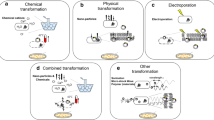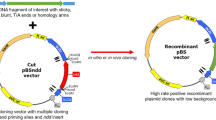Abstract
The high-throughput, cost-efficient transformation systems determine the success of gene cloning and functional analysis. Among various factors that affect this transformation systems, the competence ability of target cells is one of the most important factors. We found antimicrobial peptides LFcin-B can increase the permeability of the cell membrane, and their lethal antibacterial properties can be inhibited by moderately high concentrations of Ca2+ and Mn2+. In this study, we established a convenient and rapid method (CRM) by adding small concentrations of (0.35 mg/L) and moderately high concentrations of MnCl2 (50 mM) and CaCl2 (30 mM) in transformation buffer. The transformation efficiency of E. coli cells (DH5α, JM109 and TOP10) prepared by CRM were comparable with electroporation for plasmid transformation (3.1 ± 0.3 × 109 cfu/µg). Unlike competent cells prepared using other chemical methods, those obtained using CRM method are extremely competent for receiving larger size DNA fragments (> 5000 bp) into plasmid vectors. The competent E. coli cells prepared by CRM method are particularly useful for most high-efficiency transformation experiments under normal laboratory conditions.



Similar content being viewed by others
References
Reid GA (1991) Molecular cloning: A laboratory manual, 2nd edn: by J. Sambrook, E. F. Fritsch and T. Maniatis, Cold Spring Harbor Laboratory Press, 1989. $115.00 (3 vols; 1659 pages) ISBN 0 87969 309 6. Trends Biotechnol 9:213–214
Dower WJ, Miller JF, Ragsdale CW (1988) High efficiency transformation of E. coli by high voltage electroporation. Nucleic Acids Res 16:6127
Hanahan D (1983) Studies on transformation of Escherichia coli with plasmids. J Mol Biol 166:557–580
Mccormac AC, Elliott MC, Chen DF (1998) A simple method for the production of highly competent cells of Agrobacterium for transformation via electroporation. Mol Biotechnol 9:155
Okamoto A, Kosugi A, Koizumi Y, Yanagida F, Udaka S (1997) High efficiency transformation of Bacillus brevis by electroporation. Biosci Biotechnol Biochem 61:202–203
Yi Y, Kuipers OP (2017) Development of an efficient electroporation method for rhizobacterial Bacillus mycoides strains. J Microbiol Methods 133:82–86
Luo J, Xue H, Zhao S, Liu X, Chen X, Liu J, Shen Y, Wang M (2018) Optimization of electroporation. Adv Appl Biotechnol 393
Mandel M, Higa A (1970) Calcium-dependent bacteriophage DNA infection ☆. J Mol Biol 53:159–162
Cohen SN, Chang ACY, Boyer HW, Helling RB (1992) Construction of biologically functional bacterial plasmids in vitro. Proc Natl Acad Sci USA 24:188
Pope B, Kent HM (1996) High efficiency 5 min transformation of Escherichia coli. Nucleic Acids Res 24:536
Inoue H, Nojima H, Okayama H (1990) High efficiency transformation of Escherichia coli with plasmids. Gene 96:23
Nakata Y, Tang X, Yokoyama KK (1997) Preparation of competent cells for high-efficiency plasmid transformation of Escherichia coli. Methods Mol Biol 69:129
Si SJ, Liu TF, Lei XC (2010) Optimization of condition for preparation of competent cells of methylase-deficiency E. coli with high transformation efficiency. Chin. J Biol 23:533–535 + 538
Li X, Sui X, Zhang Y, Sun Y, Zhao Y, Zhai Y, Wang Q (2010) An improved calcium chloride method preparation and transformation of competent cells. Afr J Biotechnol 9:8549–8554
Taketo A, Kuno S (1974) Sensitivity of Escherichia coli to viral nucleic acid VII. Further studies on Ca2+-induced competence. J Biochem 75:59–67
Green MR, Sambrook J (2018) The Hanahan method for preparation and transformation of competent Escherichia coli: high-efficiency transformation, 3rd edn. Cold Spring Harbor Protocols, New York. https://doi.org/10.1101/pdb.prot101188
Chen X, Guo P, Xie Z, Shen P (2001) A convenient and rapid method for genetic transformation of E. coli with plasmids. Antonie Van Leeuwenhoek 80:297
Tu Z, He G, Li KX, Chen MJ, Chang J, Chen L, Yao Q, Liu DP, Ye H, Shi J (2005) An improved system for competent cell preparation and high efficiency plasmid transformation using different Escherichia coli strains. Electron J Biotechnol 8:113–120
Sharma A, Girdhar A, Srivastava N, Sharma A, Girdhar A, Srivastava N (2012) Development of strategy for competent cell preparation and high efficiency plasmid transformation using different methods. S Pac J Nat Appl Sci 29:17–20
Carrillo C, Giraldo M, Cavia MM, Alonso-Torre SR (2017) Effect of oleic acid on store-operated calcium entry in immune-competent cells. Eur J Nutr 56:1077–1084
Wang S, Li Z, Chen Z (2017) Chemotransformation of bacterial cells without heat-shock. Chem Res Chin Univ 33:160–165
da Silva B, de Freitas VA, Nascimentoneto LG, Carneiro VA, Arruda FV, de Aguiar AS, Cavada BS, Teixeira EH (2012) Antimicrobial peptide control of pathogenic microorganisms of the oral cavity: a review of the literature. Peptides 36:315–321
Brogden KA (2005) Antimicrobial peptides: pore formers or metabolic inhibitors in bacteria? Nat Rev Microbiol 3:238
Montales KP, Wade HM, Figueroa DM, Darling LE, Elmore DE (2018) Characterizing changes in antimicrobial peptide mechanism against different bacterial strains. Biophys J 114:456a
Wang S, Tu J, Zhou C, Li J, Huang L, Tao L, Zhao L (2014) The effect of Lfcin-B on non-small cell lung cancer H460 cells is mediated by inhibiting VEGF expression and inducing apoptosis. Arch Pharmacal Res 38:261
Sambrook J, Fritsch E, Maniatis T (1989) Molecular cloning: a laboratory manual 1989, 2nd edn. Cold Spring Harbor Laboratory, New York
Ibrahim HR, Sugimoto Y, Aoki T (2000) Ovotransferrin antimicrobial peptide (OTAP-92) kills bacteria through a membrane damage mechanism. Biochim Biophys Acta (BBA) Gen Subj 1523:196–205
X-j Feng, J-h Wang, A-s Shan, Teng D, Y-l Yang, Yao Y, G-p Yang, Y-c Shao, Liu S, Zhang F (2006) Fusion expression of bovine lactoferricin in Escherichia coli. Protein Expr Purif 47:110–117
Lederberg EM, Cohen SN (1974) Transformation of Salmonella typhimurium by plasmid deoxyribonucleic acid. J Bacteriol 119:1072–1074
Jones IM, Primrose SB, Robinson A, Ellwood DC (1981) Effect of growth rate and nutrient limitation on the transformability of Escherichia coli with plasmid deoxyribonucleic acid. J Bacteriol 146:841
Morrison DA (1979) Transformation and preservation of competent bacterial cells by freezing. Methods Enzymol 68:326–331
Hanahan D, Jessee J, Bloom FR (1991) Plasmid transformation of Escherichia coli and other bacteria. Methods Enzymol 204:63
Dhingra G, Kumari R, Bala S, Majumdar S, Malhotra S, Sharma P, Lal S, Cullum J, Lal R (2003) Development of cloning vectors and transformation methods for Amycolatopsis. J Ind Microbiol Biotechnol 30:195–204
Kozlov SA, Vassilevski AA, Grishin EV (2008) Antimicrobial peptide precursor structures suggest effective production strategies. Recent Pat Inflamm Allergy Drug Discov 2:58–63
Li Y (2011) Recombinant production of antimicrobial peptides in Escherichia coli: a review. Protein Expr Purif 80:260–267
Fenglong M (2008) Study on the synthesis of lactoferricin bovine (Lfcin B) gene and its expression in microzyme. J Anhui Agric Sci 36:446
Wu J, Han Y, Liu K, Zhang Y, Liu Y (2010) LfcinB mutant gene cloned in Escherichia coli fusion expression and activity determ ination. Biotechnol Bull 03:85–89
Xing F, Yin Y, Huang R, Kong X, Li T, Tang Z, Zhang Y (2008) Expression of recombinant lactoferricin B in E. coli. Food Sci 29:221–224
Yi J, Huang D, Li L, Lin F (2007) Expression and identification of LfcinB gene in Pichia pastoris. Microbiol China 34:7–11
Acknowledgements
This study is supported by Natural Science Foundation of Hubei Province(Grant No.2016CFB630), the Basic Research for Application Project of Wuhan (Grant No. 2015011701011595) and National Natural Science Foundation of China (NSFC31701100, NSFC31600981, NSFC31600801). We also would like to thank LetPub (www.letpub.com) for providing linguistic assistance during the preparation of this manuscript.
Author information
Authors and Affiliations
Corresponding author
Rights and permissions
About this article
Cite this article
Liu, J., Chang, W., Pan, L. et al. An Improved Method of Preparing High Efficiency Transformation Escherichia coli with Both Plasmids and Larger DNA Fragments. Indian J Microbiol 58, 448–456 (2018). https://doi.org/10.1007/s12088-018-0743-z
Received:
Accepted:
Published:
Issue Date:
DOI: https://doi.org/10.1007/s12088-018-0743-z




